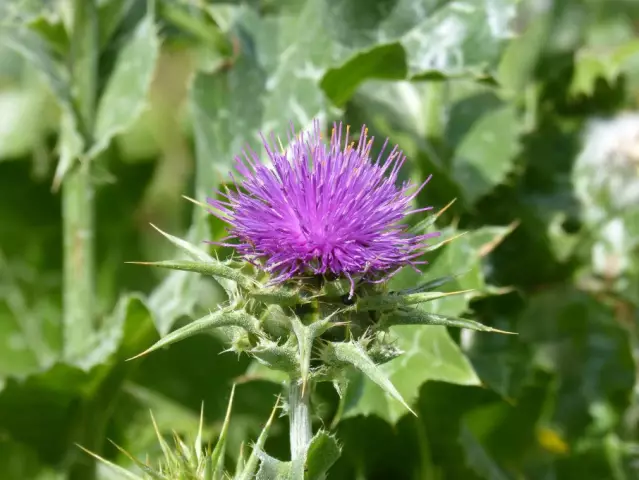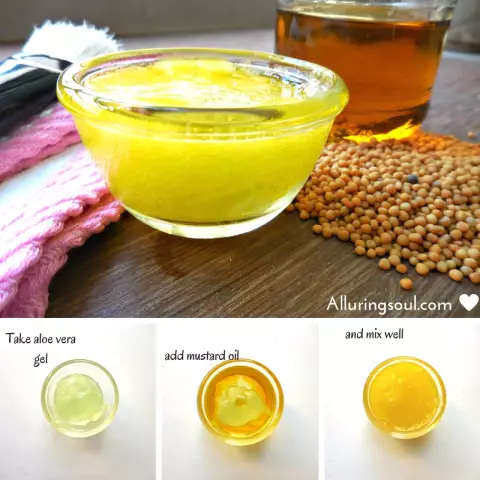- Author Rachel Wainwright [email protected].
- Public 2023-12-15 07:39.
- Last modified 2025-11-02 20:14.
Thymodepressin
Thymodepressin: instructions for use and reviews
- 1. Release form and composition
- 2. Pharmacological properties
- 3. Indications for use
- 4. Contraindications
- 5. Method of application and dosage
- 6. Side effects
- 7. Overdose
- 8. Special instructions
- 9. Application during pregnancy and lactation
- 10. Use in childhood
- 11. Drug interactions
- 12. Analogs
- 13. Terms and conditions of storage
- 14. Terms of dispensing from pharmacies
- 15. Reviews
- 16. Price in pharmacies
Latin name: Thymodepressin
ATX code: L04AA
Active ingredient: sodium gamma-D-glutamyl-D-tryptophan (thymodepressin) [Gamma-D-glutamyl-D-tryptophan sodium (Thymodepressin)]
Manufacturer: CJSC MBNPK Cytomed (Russia); FSUE "Moscow Endocrine Plant" (Russia)
Description and photo update: 2020-11-02

Thymodepressin is an immunosuppressive drug.
Release form and composition
Dosage forms of Thymodepressin:
- metered dose nasal spray (0.25 mg / dose; 0.5 mg / dose): clear, colorless liquid with a possible characteristic odor (3, 5 or 10 ml in a glass bottle, sealed with a cap / lid and equipped with a pump-dispenser with a plastic body; in a cardboard box 1 bottle);
- nasal drops: clear, colorless liquid with a possible specific odor (5 ml in a glass vial, sealed with a cork and rolled in a cap; in a cardboard box 1 vial with a dropper cap or pipette stopper);
- solution for intramuscular (i / m) administration: colorless transparent liquid with a possible characteristic odor (1 ml in glass ampoules, 5 ampoules in a blister, in a cardboard box 1-2 contour packs with or without an ampoule scarifier or knife - if ampoules have a ring or a break point).
Each pack also contains instructions for the use of Timodepressin.
1 liter of spray contains:
- active substance: gamma-D-glutamyl-D-tryptophan disodium salt (thymodepressin) - 2.5 or 5 g;
- additional components: sodium chloride, sodium hydroxide 1 M, benzalkonium chloride, water for injection.
1 liter of nasal drops or solution for intramuscular administration contains:
- active substance: gamma-D-glutamyl-D-tryptophan sodium (thymodepressin) - 1 g;
- additional components: sodium chloride, sodium hydroxide 1 M, water for injection.
Pharmacological properties
Pharmacodynamics
Thymodepressin is a synthetic peptide composed of D-amino acids (tryptophan and glutamic acid) linked by a γ-peptide bond. Demonstrates immunosuppressive effect, suppresses the course of reactions of cellular and humoral immunity.
The active substance contained in the composition of Thymodepressin in the peripheral blood reversibly lowers the total number of lymphocytes, leading to a proportional decrease in the level of both helpers and suppressors. Inhibits colony formation and the entry of hematopoietic stem cells into the S-phase. Reduces the number of activation markers on lymphocytes, blocks the proliferation of T cells.
Thymodepressin suppresses the spontaneous production of tumor necrosis factor-alpha (TNF-α), causes an increase in the production of interleukin 7 (IL-7) and does not affect the production of interleukin 1 (IL-1). The active substance attenuates the acute graft versus host reaction (GVHD) and reduces chronic GVHD by 90% when the drug is administered to the donor and recipient, provides faster and more cooperative entry into the proliferative phase of healthy progenitor cells and the restoration of leukopoiesis.
Thymodepressin is non-toxic, effective in low doses, and has a wide therapeutic dose range.
Pharmacokinetics
With parenteral administration, an average of 90% of the active substance penetrates into the systemic circulation. The maximum concentration (C max) in the bloodstream is recorded 5 minutes after administration. The absorption of thymodepressin in this case occurs at the injection site.
With intranasal administration, the bioavailability of the drug is also at least 90%, absorption proceeds through the nasal mucosa.
The process of biotransformation of the drug is 70% carried out in the liver. In organs and tissues, C max are observed 15 minutes after administration. In the liver and bone marrow value C max of the drug in the blood exceed those in the 3.45 and 9.5 times, respectively. In plasma, the level of the active substance is 1.5 times higher, which indicates its greatest accumulation in the plasma, and not in the blood cells.
After parenteral and intranasal administration, the drug is excreted by the kidneys (55-59%) and through the intestines (13-19%). The half-life (T 1/2) is approximately 14 hours. The agent is completely eliminated within 24 hours and does not accumulate in the body.
Indications for use
Thymodepressin is used in adults and children from two years of age as a monotherapy drug and as part of the complex treatment and prevention of recurrence of the following autoimmune diseases:
- autoimmune pathologies of connective tissue, including rheumatoid arthritis; secondary rheumatoid syndrome against the background of tumors, including lymphatic;
- chronic recurrent dermatoses: atopic dermatitis, psoriasis, eczema, pemphigus; symptomatic treatment of skin T-cell lymphomas (TCLK);
- hematological diseases: idiopathic thrombocytopenic purpura (ITP), autoimmune hemolytic anemia, two- and three-growth cytopenias, including secondary ones against the background of chronic lymphocytic leukemia (CLL) and lymphocytic lymphomas.
Also, the use of Thymodepressin is indicated in the following cases:
- cytostatic chemotherapy and radiation therapy - in order to protect and preserve stem cells and accelerate the exit from granulocytopenia;
- bone marrow, organ and tissue transplantation - to prevent transplant rejection.
Contraindications
- uncontrolled arterial hypertension;
- infectious (viral, parasitic, bacterial, fungal) lesions in the acute phase;
- children's age up to two years;
- pregnancy and lactation;
- individual intolerance to the components in Timodepressin.
Thymodepressin, instructions for use: method and dosage
Thymodepressin in the form of nasal drops and nasal metered spray (0.25 / 0.5 mg per dose) is administered intranasally, solution for intramuscular administration is administered intramuscularly.
Intranasal Timodepressin is prescribed mainly as maintenance therapy and for the prevention of relapse, as well as in the treatment of children.
The recommended dosage regimen for Timodepressin, depending on the indications:
- atopic dermatitis: 1-2 ml of solution intramuscularly for 7-14 days, after a two-day break it is possible to extend the course of treatment; the spray is prescribed in each nasal passage for 1-2 doses for 7-14 days, after a two-day break, a second course is possible; children are injected into each nasal passage 1-2 ml of nasal drops of Timodepressin for 7 days and then repeat a similar course with an interval of 2 days; the duration of therapy depends on the clinical morphological characteristics of the disease;
- psoriasis: i / m daily, 1-2 ml, course - 7-10 days, taking into account the clinical situation, repeated courses are allowed up to 5 times with an interval of 2 days; intranasally daily in each nasal passage for 1-2 doses of spray for 7-10 days or 1-2 ml drops of Timodepressin for 10-14 days, after an interval of 2 days, prolongation of treatment is possible; with generalized psoriatic erythroderma - intramuscularly 2 ml daily for 14 days, then intranasally in the same course in combination with glucocorticosteroids (GCS) in medium doses (prednisolone 40-60 mg);
- eczema: i / m daily, 1-2 ml for 10 days, then a similar course is carried out after 2-5 days of break; Intranasally, a Timodepressin spray is injected in 1-2 doses or 1-2 ml drops in each nasal passage for 10 days, then a 10-day course is repeated with an interval of 2-5 days;
- pemphigus (used for various types of disease in combination with corticosteroids): i / m daily, 1 ml for 14 days in combination treatment with prednisolone in a daily dose of 60-80 mg, 7-10 days after the start of therapy, the daily dose of prednisolone is reduced by ⅓ with a further gradual decrease - every 4-5 days by 5 mg, if necessary, prednisolone is used in a maintenance daily dose of 5 mg;
- TCLK: intramuscularly 2 ml daily, in three courses of 7 days at intervals of 5 days while taking medium doses of GCS (prednisolone, 30-40 mg);
- rheumatoid arthritis: 1-3 ml of solution intramuscularly or spray intranasally into each nasal passage for 1-2 doses for 7-14 days, then 2 times every 7 days at the same dose, the course of therapy is 16 weeks; intranasally Timodepressin is prescribed primarily to prevent relapse and as a maintenance treatment; drops are prescribed in 1-2 ml for 5-10 days, then 2 times in 7 days in the same dose.
Use after cytostatic therapy
To reduce the myelotoxic effect of cytostatic therapy, Thymodepressin is recommended to be administered intramuscularly, 1-2 ml of solution daily for 5-7 days. Injections begin 24-48 hours before the first course of cytostatic chemotherapy (first and second injections), the third administration is carried out 12 hours before the start of polychemotherapy. Taking into account the duration of the course of chemotherapy, the solution is continued to be used daily 1 time per day at a dose of 1-2 ml. The main indicator of effectiveness is the number of granulocytes and leukocytes recorded 3 days before the start of the next course of cytostatic therapy.
To weaken the myelotoxic effect, Timodepressin can also be administered intranasally, 1-2 ml of nasal drops or 1-2 doses of spray in each nasal passage for 5-7 days, or fractionally 2-3 times a day, 0.5 ml drops or 1 dose of spray in each nasal passage, starting 24-48 hours before the first course of chemotherapy. Then, once a day, the spray is administered daily for 2-5 days, depending on the course of chemotherapy.
Thymodepressin is indicated for use before courses of polychemotherapy, lasting no more than 14 days and at intervals of at least 14 days. In the case of long-term, continuous schemes of administration of cytostatics, the appointment of the drug is impractical.
Against the background of a recurrent course of primary and secondary autoimmune cytopenias, Timodepressin should be used as two courses of intramuscular injections. After they have been carried out, when a positive effect is observed in order to stabilize the process, it is allowed to switch to a course intranasal administration of the drug for several months. If after the first two courses of treatment the effect was insufficient, it is recommended to increase the daily dose by 2-3 times and reduce the interval between courses to 7 days. When the desired result is achieved, they switch to supportive treatment, during which it is possible to reduce the dose of Thymodepressin and increase the interval between courses.
In the case of the appointment of Timodepressin in severe recurrent course in combination with cytostatic immunosuppressants, the dose of the latter is reduced by 2 times, when the desired effect is achieved, these drugs are canceled.
The recommended dosage regimen of Thymodepressin in pediatric practice, depending on the age of the patients:
- children from 2 to 12 years old: 1 time per day intramuscularly, 0.5-1 ml of solution or intranasally in each nasal passage, 0.5-1 ml of nasal drops or 1-2 doses of spray; the course is 7-10 days, then after a two-day break, if necessary, the course is repeated, 1-5 courses are allowed;
- adolescents over 12 years old: 1 time per day i / m 1-2 ml of solution or intranasally into each nasal passage, 1-2 ml of nasal drops or 1-2 doses of spray; the course is 7-10 days, then after a two-day interval another 1-2 similar courses are carried out.
Side effects
After the second course of treatment with the drug, a transient decrease in the number of leukocytes can be observed while maintaining the leukocyte count of the peripheral blood.
Allergic reactions may develop against the background of the use of the spray.
Overdose
No cases of overdose of Thymodepressin have been recorded.
special instructions
Thymodepressin therapy, as well as other immunosuppressive drugs, can aggravate latent fungal, bacterial, viral and parasitic infections. When the first clinical signs of an infectious process appear, the necessary pathogenetic therapy should be carried out.
If unforeseen negative effects of the drug occur during treatment, an urgent need to consult a doctor.
Application during pregnancy and lactation
For pregnant and breastfeeding women, therapy with a drug is contraindicated.
Pediatric use
Thymodepressin is used in children from two years of age according to the recommended dosage regimen.
Drug interactions
Thymodepressin should not be used concurrently with drugs that have immunostimulating properties.
When combined with cytostatics, the drug does not lead to a weakening of their antitumor effect.
Analogs
The analogs of Thymodepressin are Ecoral, Tacrolimus, Tacrolimus-Acri, Tacrolimus-Teva, Tacrolimus-Stada, Grastiva, Advagraf, Pangraf, Priluxid, Protopic, Takrosel, Prograf, Takropic, Rapamun, etc.
Terms and conditions of storage
Store out of the reach of children, protected from light, at a temperature of 2 to 25 ° C.
The shelf life is 3 years.
Terms of dispensing from pharmacies
Dispensed by prescription.
Reviews about Thymodepressin
Rare reviews of Thymodepressin are rather ambiguous and relate mainly to the treatment of chronic recurrent dermatoses. Some patients consider the drug to be an effective immunosuppressive agent that helps in the treatment of chronic skin lesions, such as atopic dermatitis, eczema, psoriasis, pemphigus. Other patients consider Timodepressin very expensive and completely ineffective, since after a course of therapy for dermatoses (especially psoriasis) they did not notice any improvement in their condition. There are no complaints about side effects.
The price of Timodepressin in pharmacies
The price for Timodepressin can be:
- dosed nasal spray (0.5 mg / dose): 1700 rubles for 5 ml (40 doses);
- solution for intramuscular injection: 2800 rubles. for 5 ampoules of 1 ml.

Maria Kulkes Medical journalist About the author
Education: First Moscow State Medical University named after I. M. Sechenov, specialty "General Medicine".
Information about the drug is generalized, provided for informational purposes only and does not replace the official instructions. Self-medication is hazardous to health!






